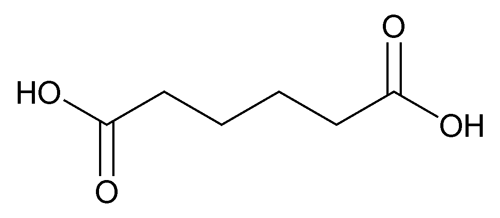Adipic Acid
(a dip' ik).
DEFINITION
Adipic Acid contains NLT 99.0% and NMT 101.0% of C6H10O4, calculated on the dried basis.
IDENTIFICATION
ASSAY
• Procedure
Sample:
60 mg
Titrimetric system
(See Titrimetry  541
541 .)
.)
Mode:
Direct titration
Titrant:
0.1 N sodium hydroxide VS
Blank:
50.0 mL of water
Endpoint detection:
Colorimetric
Analysis:
Dissolve the Sample in 50 mL of water. Add 0.2 mL of phenolphthalein TS, and titrate with 0.1 N sodium hydroxide VS to a permanent pale pink endpoint. Perform a blank determination. Calculate the percentage of adipic acid (C6H10O4) in the Sample taken:
Result = [(V  B) × N × F × 100]/W
B) × N × F × 100]/W
| V | = | = titrant volume consumed by the Sample (mL) |
| B | = | = titrant volume consumed by the Blank (mL) |
| N | = | = titrant actual normality (mEq/mL) |
| F | = | = equivalency factor, 73.1 mg/mEq |
| W | = | = weight of the Sample (mg) |
Acceptance criteria:
99.0%–101.0% on the dried basis
IMPURITIES
• Residue on Ignition  281
281 :
NMT 0.1%
:
NMT 0.1%
• Limit of Nitrates
Standard stock solution:
1.63 mg/mL of potassium nitrate
Standard solution:
Dilute 1 mL of the Standard stock solution with water to 10 mL. Dilute 1 mL of this solution with water to 50 mL to obtain a solution containing 2 µg/mL of nitrate.
Sample solution:
Transfer 5 g of Adipic Acid to a 50-mL volumetric flask. Dissolve in water, with heating, and dilute with water to volume. Allow to cool and crystallize, then pass through a sintered-glass filter. Wash the filter with water, and collect the filtrate and washings until a volume of 50 mL is obtained. [Note—This solution is also to be used for Chloride, Sulfate, Iron, and Heavy Metals. ]
Control:
2 mg/L of potassium permanganate
Analysis:
Transfer 1.0 mL of the Sample solution, 1.5 mL of the Standard solution, and 1 mL of water (blank) to three separate flasks. To each flask add 2 mL of concentrated ammonia, 0.5 mL of 10 mg/mL manganese sulfate, and 1 mL of 10 mg/mL sulfanilamide, and dilute each solution with water to 20 mL. Add 100 mg of zinc powder to each of the three flasks, and cool in an ice bath for 30 min, shaking the solutions periodically. Separately filter 10 mL of each solution, cool in an ice bath, and then add 2.5 mL of hydrochloric acid and 1 mL of 10 mg/mL of naphthylethylenediamine dihydrochloride. Allow the solutions to stand at room temperature for 15 min.
System suitability:
The test is invalid if the concomitantly prepared blank solution is darker than the Control.
Acceptance criteria:
The color of the solution containing the Sample solution is not darker than the concomitantly prepared solution containing the Standard solution (NMT 30 ppm).
• Heavy Metals, Method I  231
231 :
NMT 10 ppm
:
NMT 10 ppm
• Chloride and Sulfate, Chloride  221
221
Sample:
A 5-mL portion of the Sample solution from Limit of Nitrates
Analysis:
Proceed as directed in the chapter.
Acceptance criteria:
The Sample shows no more chloride than a corresponding 0.14-mL portion of 0.020 N hydrochloric acid (NMT 0.02%).
• Chloride and Sulfate, Sulfate  221
221
Sample:
A 5-mL portion of the Sample solution from Limit of Nitrates
Analysis:
Proceed as directed in the chapter.
Acceptance criteria:
The Sample shows no more sulfate than a corresponding 0.26-mL portion of 0.020 N sulfuric acid (NMT 0.05%).
• Iron  241
241
Sample:
A 10-mL portion of the Sample solution from Limit of Nitrates
Analysis:
Proceed as directed in the chapter.
Acceptance criteria:
NMT 10 ppm
SPECIFIC TESTS
• Melting Range or Temperature  741
741 :
151
:
151 –154
–154
• Loss on Drying  731
731 :
Dry a sample at 105
:
Dry a sample at 105 to constant weight; it loses NMT 0.2% of its weight.
to constant weight; it loses NMT 0.2% of its weight.
ADDITIONAL REQUIREMENTS
• Packaging and Storage:
Preserve in a tight containers. No storage requirements specified.
Auxiliary Information—
Please check for your question in the FAQs before contacting USP.
| Topic/Question | Contact | Expert Committee |
|---|---|---|
| Monograph | Robert H. Lafaver, M.S.
Scientific Liaison 1-301-816-8335 |
(EXC2010) Monographs - Excipients |
| Reference Standards | RS Technical Services 1-301-816-8129 rstech@usp.org |
USP35–NF30 Page 1684
Pharmacopeial Forum: Volume No. 31(1) Page 87

